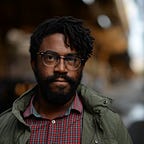A Media Model For Chicago
Notes, tweets and worksheets on envisioning a thriving media landscape, from City Bureau’s Public Newsroom #33
First things first, if you missed our Thursday, August 31, Public Newsroom, you can now listen in each week via our audio livestream (Public Newsroom Radio, anyone?). Join us live on the digital airwaves or bookmark this page for later listening: http://www.spreaker.com/user/citybureau
Last night’s workshop was a long time in the making. Our invitation to the public went like this:
Chicago media is in a moment of transition. The Chicago Sun-Times is under new ownership, local nonprofit and community news outlets are working for change on the ground as national outlets move to the city, and foundations are seeking to stabilize a fractured media ecosystem.
At City Bureau, we believe a thriving media ecosystem is key to an informed citizenry, but solutions to our collective challenges will require diverse voices, ideas and input. #PublicNewsroom #33 is one of many places where this conversation will take place.
And it did. Nearly 50 journalists, editors, community members, students and freelancers stopped by our South Side newsroom to hear Sheila Solomon (Rivet Radio, Democracy Fund, formerly of the Chicago Tribune), Scott Smith (Digital and Social Strategist, formerly of Touchvision) and Blanca Rios (ABC7 and NAHJ Chicago chapter president) discuss sustainable media models, newsroom diversity and Chicago’s local media ecosystem.
As always, we kicked the night off by having our audience introduce themselves and tell the crowd why they came from across the city to spend time at our space. This portion of the night takes a minute but, honestly, it’s worth every second—it breaks the ice and puts audience members on the same plane as panelists. (Not to mention, it allows attendees to more easily identify connections between each other, and, if they choose, to share contact information after the event.)
We eventually got down to business.
I started by posing a general question to the panel to get our collective creative thoughts flowing: “When you think of media models that Chicago needs to thrive, where do your thoughts go?”
Meanwhile, City Bureau’s lead editor Bettina Chang started a thread that you can follow here:
I can’t thank our panelists enough for their readiness to go in on the issues—and our audience for sharing so many questions and insights throughout the conversation.
The first eye-opening moment came via a question from Rivet Radio’s Sheila Solomon:
The response was telling. Of a diverse group of ~50 people in the room, less than a handful raised their hands when asked if they feel represented in the Chicago Tribune and the Chicago Sun-Times. It’s a point Blanca Rios raised not just in terms of audience, but also in the highest levels of newsroom staffing:
While alarming, this isn’t news on the South Side of Chicago. In many ways, City Bureau was founded as an infrastructural and solutions-based response to this core issue which, to us, involves a few key points: 1) a lack of community trust in media, 2) a lack of equitable reporting on the part of news outlets, and 3) a traditional gate-keeper approach that doesn’t acknowledge the boons of providing direct services around information and engagement.
At the same time, our panelists agreed that an insistence on labeling Chicago a “two-paper town” is flawed in itself. It doesn’t reflect the many community, ethnic and alternative presses that currently exist on Chicago’s media landscape:
Some folks in the audience agreed:
While Public Newsroom #33 tackled issues of resource distribution for existing and incoming nonprofit news outlets via foundation support, we kept coming back to public support as a means of decreasing reliance on “power” and special interests:
Our panelists and audience had clearly spent time thinking on this:
As we’ve noted in past blogs and events, this last point is in many ways the question that launched City Bureau:
While we value our expert panelists for their insight, experience and time spent with our team, my personal favorite portion of each #PublicNewsroom event is the workshop. For this event, we had our panelists join the audience for small-group discussions.
This included filling out a worksheet, which serves two functions: 1) to help attendees explore their media consumption habits and and how that connects with their daily lives, 2) to provide us with vital data and information that helps us refine our work and events.
As always, we saved time at the end of the night for each group to share out their discussions to the full group for further reflection:
Overall, feedback from Public Newsroom #33 was earnest and affirming—City Bureau Community Engagement Director Andrea Faye Hart may have summed it up best:
Some last housekeeping notes:
To follow our reporting and engagement efforts, join our twice-a-month newsletter for updates. Reporting and free community-based events like this is brought to you by a staff of experienced and emerging local journalists working collaboratively to share skills, stories and information in your community. Subscribers are vital to continue our mission.
To support our work at any amount, visit our website.
Lastly, for some further reading, please see the material Scott Smith collected during his preparation for our Public Newsroom panel and workshop from folks like Jeff Jarvis, Jack Conte, Texas Tribune and Nieman Lab. We also encourage you to read his Day 2 thread on some of the issues that weren’t raised during our event (to be sure, these are issues we’ll dig deeper on in a #PublicNewsroom continuation of this conversation):
